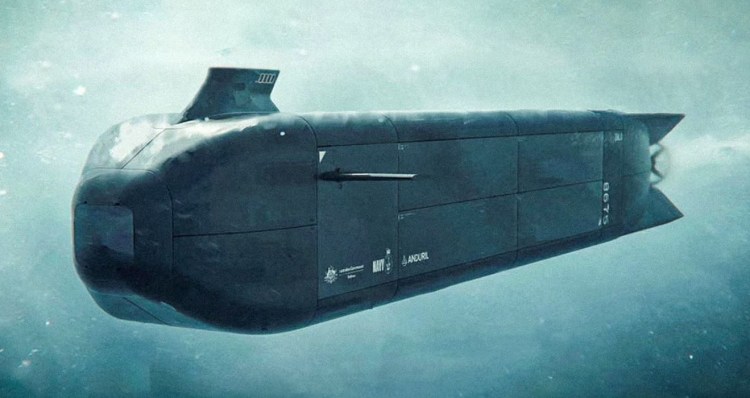Another high-tech boost for the US military with the arrival of the Ghost Shark XL-AUV (Extra-Large Autonomous Undersea Vehicle), an autonomous underwater drone from Anduril Industries.
Flown in by a Royal Australian Air Force C-17 Globemaster III last week, this cutting-edge tech is now set for serious military testing.
It’s a big move in US-Australia defense teamwork aimed at strengthening undersea capabilities across the Pacific.
With the US Navy focusing more on unmanned systems, it looks like this partnership is all about staying ahead in maritime operations.
Here’s our take on the matter.
The Arrival and Testing of Ghost Shark Drone
The arrival of the Ghost Shark in the US waters is not just about adding a new piece of tech to the arsenal; it’s a big step in boosting how well our allied forces work together.
The XL-AUV made its first big splash in the US at the recent Rim of the Pacific (RIMPAC) 2024 exercise in Hawaii. This biennial event, led by the US Navy, gave attendees a chance to see this cutting-edge, uncrewed undersea vehicle (UUV) up close.
Testing the Ghost Shark in these waters is key—it’ll help us see how it performs in different environments and how well it meshes with both American and Allied naval forces.
So, this isn’t just about checking off boxes of acquiring the latest tech; it’s about the joint efforts to strengthen Western military ties and get ready for whatever the future might throw at us.
Not to mention the long-shared strong military relationship, especially within the Indo-Pacific region.
This partnership is becoming increasingly important as both nations face rising strategic challenges in the area, including increased activity from potential adversaries (a.k.a China).
Ghost Shark Details and Specifics
Ghost Shark’s development began in Australia in 2022, with the Royal Australian Navy planning to acquire at least three units by 2025.
The version is now in American waters and is an additional model built entirely with Anduril’s own funds, offering even more opportunities for testing and deployment.
Ghost Shark is based on earlier work from the Dive-LD, another large-displacement UUV initially designed by Dive Technologies, which Anduril acquired in 2022.
Though specific details like speed, range, and endurance remain under wraps, we do know that Australian authorities intend to use Ghost Shark for persistent intelligence, surveillance, reconnaissance (ISR), and potentially strike missions.
However, the exact nature of its strike capabilities is still a mystery.
It’s possible that Ghost Shark could be equipped to launch torpedoes, missiles, loitering munitions, or even electronic warfare jammers, but nothing has been officially confirmed.
Transporting and deploying the Ghost Shark is also a flexible process.
For RIMPAC, it was shipped in a standard container and flown to Hawaii by a Royal Australian Air Force C-17A Globemaster III, showcasing how easily it can be moved to forward locations.
Australian Navy’s Ghost Shark on display, April 2024. (Anduril Industries)
Anduril’s Dr. Shane Arnott emphasized the historical secrecy surrounding subsea systems like Ghost Shark, comparing it to the discretion often associated with submarines, as The War Zone reported last week.
He did reveal that these are “very, very long-range assets,” highlighting their strategic importance.
The Ghost Shark in the US will undergo extensive testing to push the limits of its performance and autonomy.
Autonomous undersea vehicles face unique challenges, often operating independently and out of contact with human operators for extended periods.
Building trust in the UUV’s autonomous capabilities is critical, requiring extensive testing and fine-tuning of its software.
Unlike aerial or ground drones, undersea platforms have to navigate these complexities in isolation, making each trial a significant step toward fully integrating these advanced systems into future naval operations.
Importance of Drones Today
Unmanned systems like the Ghost Shark are playing an increasingly important role in today’s military.
These autonomous vehicles or drones have a lot going for them, especially when it comes to undersea missions.
The Ghost Shark is reportedly built for everything from surveillance and intelligence gathering to multi-domain operations.
The best part? It can run on its own for long stretches, making it a powerful tool for maintaining control in maritime environments.
For the US and its allies, this means a flexible and cost-effective way to stay ahead in undersea warfare.
Naval Force Boost and Indo-Pacific’s Future
The Ghost Shark XL-AUV is a serious boost for both US and Australian naval forces.
It’s designed to work hand-in-hand with existing assets like submarines and surface ships, giving the fleet a lot more flexibility and speed.
By integrating unmanned systems like the Ghost Shark with manned operations, our naval forces can adapt on the fly and stay ahead of any surprises.
Whether it’s sneaking around on surveillance missions or stepping up in direct conflicts, this versatile piece of tech is ready to handle it all, making sure our side stays one step ahead.
With tensions heating up in the Indo-Pacific, it’s clear that having advanced military tech is more important than ever.
The Ghost Shark drone gives America and Australia a real edge in dealing with these challenges, making sure they’re ready for whatever comes their way.
By doubling down on cutting-edge technologies and solidifying their alliance, these two nations are taking smart, proactive steps to keep their security tight and send a clear message to any would-be adversaries.
The Ghost Shark’s top-tier undersea warfare capabilities play a key role in this strategy, offering a versatile and powerful tool for keeping crucial maritime areas secure.
Recap and Final Thoughts
The arrival of the Ghost Shark XL-AUV in the US is a big moment for US-Australia defense ties. This state-of-the-art tech doesn’t just boost the naval power of both nations—it also deepens their strategic partnership.
By teaming up to create and roll out advanced military systems like this, America and Australia are staying ahead of the curve, ready for whatever challenges the future might bring.
As global dynamics shift, staying on top of innovation and strengthening alliances will be key to holding a strategic advantage.
The Ghost Shark drone is a perfect example of how these two allies are setting the standard in undersea warfare and securing a more stable future.
—
Disclaimer: SOFREP utilizes AI for image generation and article research. Occasionally, it’s like handing a chimpanzee the keys to your liquor cabinet. It’s not always perfect and if a mistake is made, we own up to it full stop. In a world where information comes at us in tidal waves, it is an important tool that helps us sift through the brass for live rounds.



